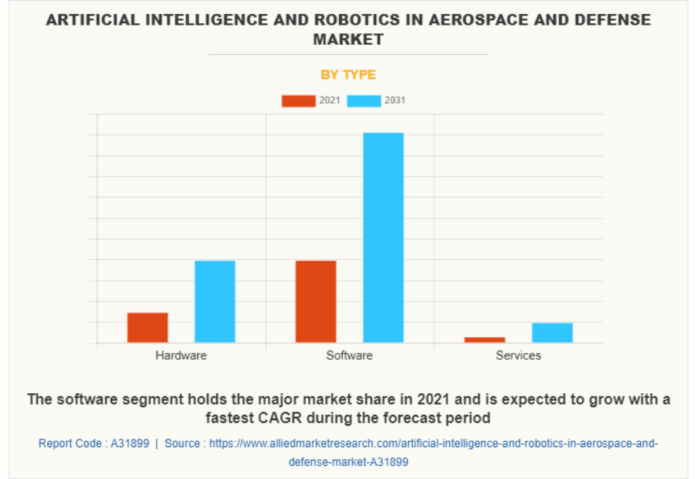
Increased investment in AI and technological advancements for workflow optimization, cloud-based solutions, and demand for AI and cognitive computing drive the market.
PORTLAND, OR, UNITED STATE, December 9, 2023 /EINPresswire.com/: Allied Market Research published a new report titled, “USD 35.9 Billion in Artificial Intelligence and Robotics in Aerospace and Defense Market Reach by 2031: Why Should Invest?” The report offers an extensive analysis of key growth strategies, drivers, opportunities, key segments, Porter’s Five Forces analysis, and the competitive landscape. This study is a helpful source of information for market players, investors, VPs, stakeholders, and new entrants to gain a thorough understanding of the industry and determine steps to be taken to gain a competitive advantage.
The global market for artificial intelligence and robotics in aerospace and defense was valued at USD 17.2 billion in 2021 and is projected to reach USD 35.9 billion by 2031, growing at a CAGR of 7.9% from 2022 to 2031.
Request Sample Report (Get Full Insights in PDF, 280 Pages) at: https://www.alliedmarketresearch.com/request-sample/32355
The use of artificial intelligence and robotics in the aerospace and defense sectors that facilitate in-depth data tracking, increased investment in AI and technological advancements for workflow optimization, the increased use of cloud-based solutions, and the growing demand for AI and cognitive computing drive the growth of the global artificial intelligence and robotics market in the aerospace and defense markets. Region-wise, North America is likely to dominate in terms of revenue in 2031.
The global market for artificial intelligence and robotics in aerospace and defense is segmented on the basis of type, application, and region. By type, the market is sub-segmented into hardware, software, and services. As per application, the market is classified into military, commercial, and space. Region-wise, the market is analyzed across North America, Europe, Asia-Pacific, and LAMEA.
If you have any questions, please feel free to contact our analyst at: https://www.alliedmarketresearch.com/connect-to-analyst/32355
Based on type, the software segment held the largest share in 2021, accounting for nearly three-fifths of the global artificial intelligence and robotics market in the aerospace and defense markets, and would dominate the market in terms of revenue through 2031. The same segment is estimated to witness the fastest CAGR of 8.8% during the forecast period. The report also discusses the hardware and services segments.
In terms of application, the military segment captured the largest market share of more than three-fifths of the global market for artificial intelligence and robotics in the aerospace and defense markets in 2021 and is expected to lead the way during the forecast period. Moreover, the same segment is likely to achieve the fastest CAGR of 8.4% through 2031. The report also studies the commercial and space segments.
Enquiry Before Buying: https://www.alliedmarketresearch.com/purchase-enquiry/32355
Based on region, the market in North America was the largest in 2021, accounting for nearly two-fifths of the global artificial intelligence and robotics market in the aerospace and defense markets in 2021, and is likely to maintain its dominance during the forecast period. However, the market in Asia-Pacific is expected to manifest the highest CAGR of 9.4% from 2022 to 2031. The other regions analyzed in the study include Europe and LAMEA.
The leading players in the global artificial intelligence and robotics in aerospace and defense markets analyzed in the research include Airbus SE, IBM Corporation, Boeing Company, GE Aviation, Thales Group, Lockheed Martin Corporation, Intel Corporation, Raytheon Technologies Corporation, General Dynamics Corporation, and Microsoft Corporation.
Buy Now & Get Exclusive Discount on this Report (280-page PDF with Insights, Charts, Tables, and Figures) at: https://www.alliedmarketresearch.com/artificial-intelligence-and-robotics-in-aerospace-and-defense-market/purchase-options
Covid-19 Scenario:
● The outbreak of the COVID-19 pandemic had a negative impact on artificial intelligence and robotics in the aerospace and defense markets.
● Owing to travel bans, the revenue of airport operators and airlines declined in 2020 and 2021 in the commercial airline business. Consequently, the use of artificial intelligence and robotics in the aerospace and defense markets saw a slight decline.
● However, some major airlines and airport authorities invested in the implementation of artificial intelligence in various passenger processes at airports to improve safety and efficiency during the pandemic.
Also read: Organizations should be driven based on people and processes instead of emphasizing technology
Do Follow: CIO News LinkedIn Account | CIO News Facebook | CIO News Youtube | CIO News Twitter
About us:
CIO News, a proprietary of Mercadeo, produces award-winning content and resources for IT leaders across any industry through print articles and recorded video interviews on topics in the technology sector such as Digital Transformation, Artificial Intelligence (AI), Machine Learning (ML), Cloud, Robotics, Cyber-security, Data, Analytics, SOC, SASE, among other technology topics.





